Udemy - Nuxt JS with Laravel API - Building SSR Vue JS Apps 笔记7 Nuxt - The unique parts
Installing and Using Plugins
安装一个 vue scrollto 插件,主要是在底部增加一个滚动到顶部的按钮。
要能够支持双端渲染的。
执行:
npm install vue-scrollto
记得安装完成后执行
npm run dev
新建plugins/scrollto.js文件:
import Vue from 'vue'; import VueScrollTo from 'vue-scrollto'; Vue.use(VueScrollTo);
nuxt.config.js修改如下:【全局注册】
注册完成即可使用。
posts/index.vue代码如下:
<template> <div> <h2>Making API request - the Vue way</h2> <div class="container row"> <Card class="ml-auto mr-auto" v-for="post in posts" :key="post.id" :post="post"></Card> <button class="btn btn-danger" v-scroll-to="'body'">Back to Top</button> </div> </div> </template> <script> import axios from 'axios'; import Card from "../../components/Card"; import {mapGetters} from 'vuex'; export default { name: "index.vue", components: { Card, }, // data() { // return { // posts: [], // } // }, computed: { ...mapGetters(['posts']), // allPosts() { // return this.$store.getters.posts; // } }, // mounted() { // axios.get('https://jsonplaceholder.typicode.com/todos') // .then(response => { // console.log(response); // this.posts = response.data; // }) // .catch(function (error) { // console.log(error); // }) // }, // async asyncData(context) { // let {data} = await axios.get('https://jsonplaceholder.typicode.com/posts'); // return {posts: data}; // }, // async asyncData({store}) { // let {data} = await axios.get('https://jsonplaceholder.typicode.com/posts'); // store.dispatch('setPosts', data); // }, async fetch({store}) { let {data} = await axios.get('https://jsonplaceholder.typicode.com/posts'); store.dispatch('setPosts', data); }, head: { title: 'List of posts', } } </script> <style scoped> </style>
按钮:
点击就会回到body标签的顶部。
注意使用 “’body’”而不是”body”,否则如下错误
接下来示例一个只能在client端渲染运行的plugin
NO SSR Component
安装 vue-select 插件。
执行:
npm i vue-select
新建plugins/vueselect.js
import Vue from 'vue';
import vSelect from 'vue-select';
Vue.component('v-select',vSelect);
修改nuxt.config.js 【注册】
或者如果只在client side的插件这样修改:
注册完成即可使用。
修改pages/index.vue文件
<template> <div> <h1>Hello World!</h1> <v-select v-model="selected" placeholder="Select Category" :options="['foo','bar']"></v-select> </div> </template> <script> export default { data() { return { selected: '', } } } </script>
如果不开启服务端渲染。修改pages/index.vue文件
<template> <div> <h1>Hello World!</h1> <no-ssr> <v-select v-model="selected" placeholder="Select Category" :options="['foo','bar']"></v-select> </no-ssr> </div> </template> <script> export default { data() { return { selected: '', } } } </script>
未开启服务端渲染,pagesource结果如下图:
http://localhost:3000/ 效果如下:
Nuxt ServerInit Method
接下来我们直接在store/index.js中使用actions 在整个程序启动的时候就加载需要的posts数据,
而不是单从pages/posts/index.vue页面加载刷新的时候才加载需要的posts数据。
所以删除pages/posts/index.vue页面 中的 fetch数据【或者axios.get数据】逻辑
<template> <div> <h2>Making API request - the Vue way</h2> <div class="container row"> <Card class="ml-auto mr-auto" v-for="post in posts" :key="post.id" :post="post"></Card> <button class="btn btn-danger" v-scroll-to="'body'">Back to Top</button> </div> </div> </template> <script> import axios from 'axios'; import Card from "../../components/Card"; import {mapGetters} from 'vuex'; export default { name: "index.vue", components: { Card, }, // data() { // return { // posts: [], // } // }, computed: { ...mapGetters(['posts']), // allPosts() { // return this.$store.getters.posts; // } }, // mounted() { // axios.get('https://jsonplaceholder.typicode.com/todos') // .then(response => { // console.log(response); // this.posts = response.data; // }) // .catch(function (error) { // console.log(error); // }) // }, // async asyncData(context) { // let {data} = await axios.get('https://jsonplaceholder.typicode.com/posts'); // return {posts: data}; // }, // async asyncData({store}) { // let {data} = await axios.get('https://jsonplaceholder.typicode.com/posts'); // store.dispatch('setPosts', data); // }, // async fetch({store}) { // let {data} = await axios.get('https://jsonplaceholder.typicode.com/posts'); // store.dispatch('setPosts', data); // }, head: { title: 'List of posts', } } </script> <style scoped> </style>
然后 store/index.js 中:
import axios from 'axios';
//create a store
export const state = () => ({
posts: [],
});
//getters
export const getters = {
posts(state) {
return state.posts;
},
}
//mutations
export const mutations = {
SET_POSTS(state, posts) {
state.posts = posts;
},
}
//actions
export const actions = {
// setPosts({commit}, posts) {
// commit("SET_POSTS", posts);
// },
async nuxtServerInit({commit}) {
let {data} = await axios.get('https://jsonplaceholder.typicode.com/posts');
commit('SET_POSTS', data);
}
}
即:
这样打开 http://localhost:3000/ ,但是即使不进入posts页面,vuex store中就已经有了数据:
Applying Transitions
即页面切换效果。
这里介绍全局切换效果设置:
nuxt.config.js中全局设置:
然后样式设置。
复制官方文档的
修改 assets/styles/main.css文件:
body {
background-color: azure;
}
div.jumbotron {
border-radius: 0;
background-image: url("/cbimage.jpg");
height: 300px;
background-size: cover;
}
.fade-enter-active, .fade-leave-active {
transition: opacity .5s;
}
.fade-enter, .fade-leave-to /* .fade-leave-active below version 2.1.8 */ {
opacity: 0;
}
效果:
源代码:
https://github.com/dzkjz/nuxt-learning-lesson
branch 选择




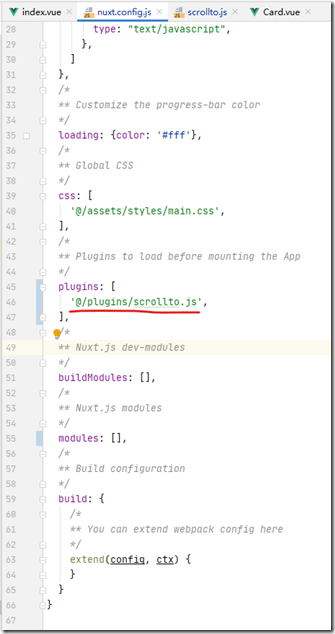
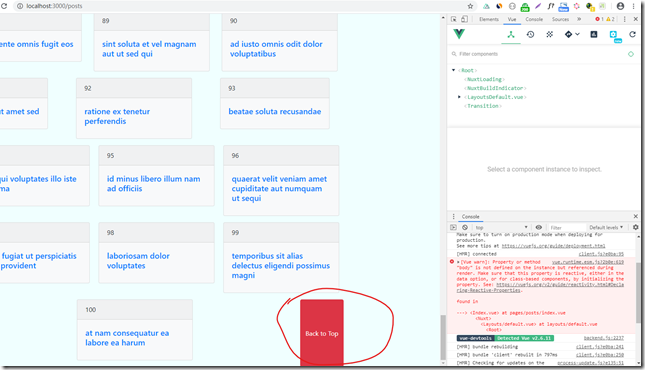

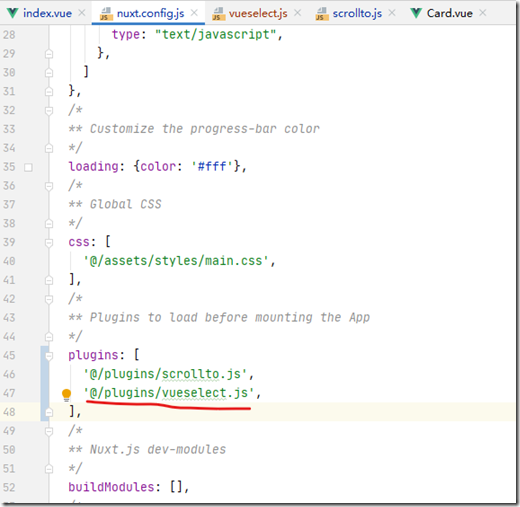
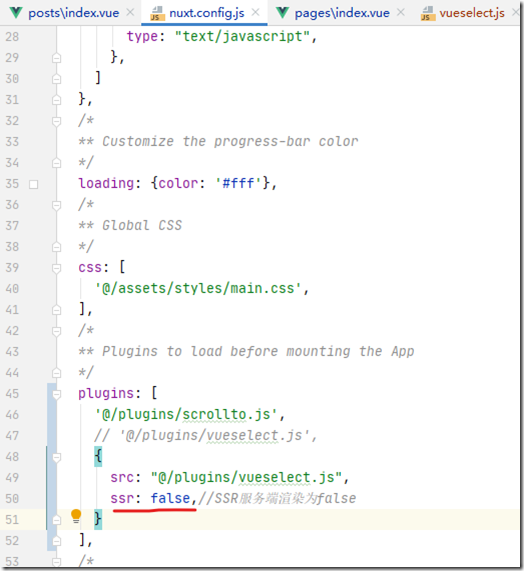


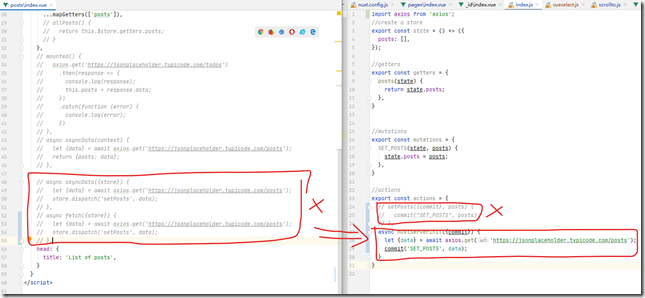

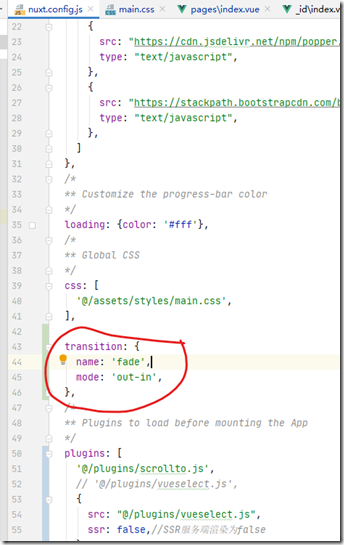
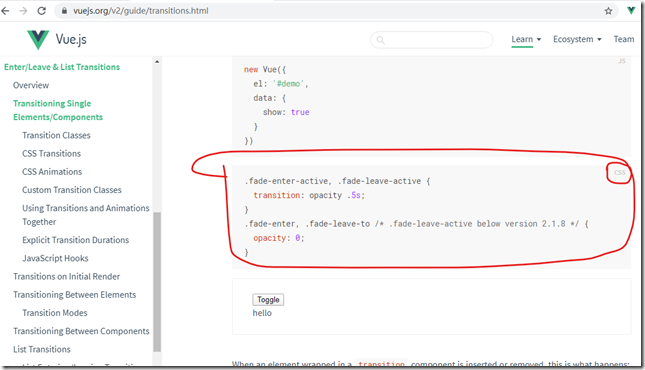



 浙公网安备 33010602011771号
浙公网安备 33010602011771号